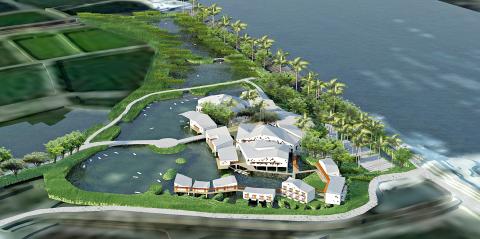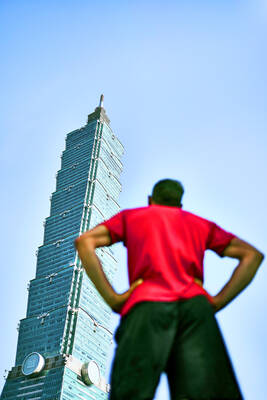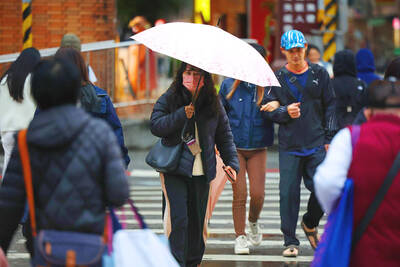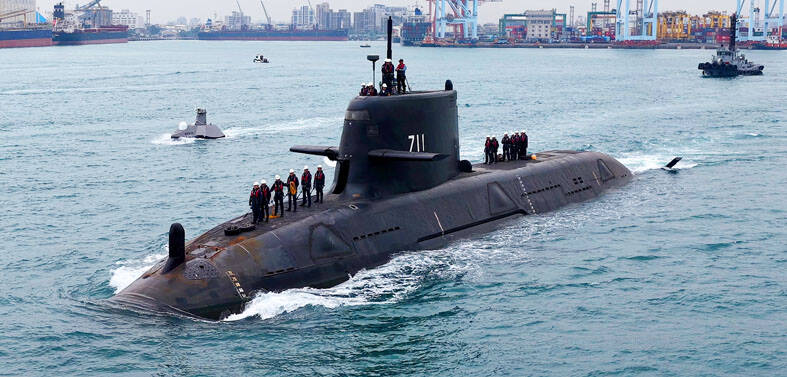“It’s a really unique spatial experience, vast and quiet, a type of landscape you do not get to experience very often in Taiwan,” architect Kuo Ying-chao (郭英釗) said, describing the large stretches of coastal wetlands and fish farms which make up Greater Tainan’s Taijiang National Park (台江國家公園). “After all, Taiwan is usually very busy visually; packed with mountains and cities.”
Kuo led his firm, Bio Architecture Formosana, in designing a new visitor’s center for the park. Currently under construction, the center is set for completion next year, and will join other well-known structures by the firm such as the Beitou Public Library and the Taipei Flora Expo Pavilions.
With a village-like complex of buildings perched on stilts above a fish farm, the design represents an architect’s interpretation of the rich natural and cultural resources offered by the park. The use of natural building materials, such as oyster shells and driftwood, add to the project’s local atmosphere.

Photo courtesy of Bio Architecture Formosana
Founded in 2009 in then Tainan City’s Annan District (安南) and Tainan County’s Cigu Township (七股), Taijiang National Park marks a break from traditional attitudes toward wilderness conservation, as it embraces a diverse array of natural, cultural and historical heritage.
While the park boasts a rich ecosystem, including mangrove forests and huge wetlands that host the endangered black-faced spoonbill in winter, traditional industries also play an essential role in the park’s attractions. Visitors can tour the park on rafts made of pipes and see oyster farming in lagoons, as well as milkfish farms in manmade ponds.
The park gained its name from the Taijiang Inland Sea, a bay that used to cover large swaths of coastal Greater Tainan. The area saw the 17th century naval battles between the Ming dynasty loyalist Cheng Cheng-kung (鄭成功), also known as Koxinga (國姓爺), and the Dutch East Indian Company. Following his defeat of the Dutch, Koxinga set up a de facto independent kingdom in Taiwan, paving the way for early waves of Han Chinese immigration.
Kuo, a local from the area, said the omnipresent fish farms played a central role in the local economy, comparing them to rice paddies in agricultural areas.
“Ever since we were kids, fish farms were everywhere. We probably thought fish farms existed since the beginning of time,” Kuo said, adding that since the site of the new visitor’s center used to be a fish farm, he saw no reason to fill it in.
“In order to build a house on a fish farm, we needed to stretch our legs a bit, like the birds do,” he said, referring to the stilts the visitor’s center rests on.
Building the visitor’s center on a fish farm also serves practical reasons, as water vapor from the pond below the building provides a natural cooling effect through specifically designed openings on the floor.
This is in tune with the green architecture approach known as “passive design,” in which natural elements such as sunlight, wind or water are employed to minimalize the consumption of energy, Kuo said.
“We are trying to minimize the use of electric devices such as air conditioners or lighting by harnessing the force of nature instead,” he said.
Designed as a cluster of buildings, Kuo’s team wanted to imitate the ventilation and shade found in the layout of the area’s traditional villages. They managed this by a computer analysis of the orientation of buildings and alley openings in the settlements.
“Settlements are built through a natural, organic process. Houses are built one after the other, while the architects are highly sensitive to natural elements such as wind and sunlight,” Kuo said.
The main challenge in the construction of the visitor’s center was to achieve the accumulated sensibilities of a settlement over a short period of time.
“Computer software can randomly allocate structures, while still adhering to certain rules. Traditional settlements themselves are a combination of random factors and fixed rules,” Kuo said.
A large number of local resources are to be used as building materials for the visitor’s center. Among them are the large number of oyster shells in the area, which have long been considered a nuisance by the oyster farming industry.
Kuo said oyster shells would be spread across roofs providing a natural barrier against heat. By covering roofs with oyster shells and the locally abundant driftwood, Kuo said the visitor’s center hopes to attract more wildlife. Insects and plants can reside amongst the crooks and crevices, potentially turning the center into a hotspot for biodiversity.
“Fish farms and wetlands are drastically different to each other in terms of biodiversity,” Kuo said. “Fish farms are driven by economic concerns. You usually only have one species of fish, while the depth of the water makes it difficult for many birds to reside.”
Wetlands, on the other hand, host a multitude of fauna and flora as they feature a diverse topography, with ponds of varying depths providing shelter to different forms of wildlife, he said.
“We might have different species of fish in our fish farm. Shading from the buildings could also create a sheltered habitat,” Kuo said, seeing the project as an “intervention” geared toward increasing biodiversity. “It’s important that we don’t destroy the local habitat through the construction of a new building, but add to its richness.”
By planning to construct a predominantly white exterior in the shape of a hill, Kuo said the visitor’s center could act as a focal point in the vast landscape.
“Taijiang is for the most part flat and spacious, unlike the mountainous terrains of the majority of the nation’s other national parks. In a sense we are creating a landscape feature, similar to the Sihcao Dajhong Temple (四草大眾廟) nearby, while avoiding being too obtrusive,” Kuo said.
He said that many of the park’s quiet charms lay hidden in the details.
“Jump onto any ridge between the fish farms, and you’ll see a lot of drought-tolerant plants, with tiny flowers blossoming all around you,” he said. “I might only see the surface of it, but it’s really a unique environment for people to admire and learn from.”

US climber Alex Honnold is to attempt to scale Taipei 101 without a rope and harness in a live Netflix special on Jan. 24, the streaming platform announced on Wednesday. Accounting for the time difference, the two-hour broadcast of Honnold’s climb, called Skyscraper Live, is to air on Jan. 23 in the US, Netflix said in a statement. Honnold, 40, was the first person ever to free solo climb the 900m El Capitan rock formation in Yosemite National Park — a feat that was recorded and later made into the 2018 documentary film Free Solo. Netflix previewed Skyscraper Live in October, after videos

NUMBERS IMBALANCE: More than 4 million Taiwanese have visited China this year, while only about half a million Chinese have visited here Beijing has yet to respond to Taiwan’s requests for negotiation over matters related to the recovery of cross-strait tourism, the Tourism Administration said yesterday. Taiwan’s tourism authority issued the statement after Chinese-language daily the China Times reported yesterday that the government’s policy of banning group tours to China does not stop Taiwanese from visiting the country. As of October, more than 4.2 million had traveled to China this year, exceeding last year. Beijing estimated the number of Taiwanese tourists in China could reach 4.5 million this year. By contrast, only 500,000 Chinese tourists are expected in Taiwan, the report said. The report

Temperatures are forecast to drop steadily as a continental cold air mass moves across Taiwan, with some areas also likely to see heavy rainfall, the Central Weather Administration (CWA) said. From today through early tomorrow, a cold air mass would keep temperatures low across central and northern Taiwan, and the eastern half of Taiwan proper, with isolated brief showers forecast along Keelung’s north coast, Taipei and New Taipei City’s mountainous areas and eastern Taiwan, it said. Lows of 11°C to 15°C are forecast in central and northern Taiwan, Yilan County, and the outlying Kinmen and Lienchiang (Matsu) counties, and 14°C to 17°C

STEERING FAILURE: The first boat of its class is experiencing teething issues as it readies for acceptance by the navy, according to a recent story about rudder failure The Hai Kun (海鯤), the nation’s first locally built submarine, allegedly suffered a total failure of stern hydraulic systems during the second round of sea acceptance trials on June 26, and sailors were forced to manually operate the X-rudder to turn the submarine and return to port, news Web site Mirror Daily reported yesterday. The report said that tugboats following the Hai Kun assisted the submarine in avoiding collisions with other ships due to the X-rudder malfunctioning. At the time of the report, the submarine had completed its trials and was scheduled to begin diving and surfacing tests in shallow areas. The X-rudder,